Introduction
Egypt is a country that feels like an open-air museum, where every corner carries echoes of an ancient civilization. Located in the northeastern part of Africa, it is one of the most historically rich destinations in the world. With its awe-inspiring pyramids, majestic temples, golden deserts, and the ever-flowing Nile River, Egypt offers a journey through thousands of years of human history. Beyond its ancient monuments, it is also a nation of vibrant cities, bustling markets, warm hospitality, and coastal retreats that attract millions of travelers each year.
Whether you are fascinated by archaeology, eager for cultural experiences, or simply looking to relax on sun-drenched beaches, Egypt has something to enchant you. This article takes you on a detailed journey through the country’s past and present, showcasing why Egypt remains an unforgettable destination for travelers from around the globe.
Historical Significance
Few countries can match Egypt’s historical influence. Its civilization, which emerged more than 5,000 years ago along the fertile banks of the Nile, left an enduring mark on art, architecture, science, and culture. Ancient Egyptians were remarkable innovators—building pyramids that defy time, developing early forms of writing, and perfecting irrigation systems that supported life in the desert.
The Dawn of Ancient Egypt
The prosperity of ancient Egypt was centered around the Nile River. Its annual floods nourished the soil, creating the conditions for a thriving agricultural society. This natural bounty supported the rise of powerful rulers, the pharaohs, who were both political leaders and divine figures. The monuments they built—pyramids, temples, and statues—remain among the most impressive achievements of humanity.
Important Historical Eras
Pharaonic Egypt (3100 BC – 332 BC):
The classical age of the pharaohs. It was during this era that the Great Pyramids of Giza, the Sphinx, and the Valley of the Kings were built.
Greco-Roman Period (332 BC – AD 641):
Egypt came under the rule of Alexander the Great and later the Romans. Alexandria emerged as a center of learning and culture, home to the legendary Library of Alexandria.
Islamic Egypt (AD 641 onwards):
Following the Arab conquest, Cairo became a hub of Islamic scholarship, architecture, and trade. This period introduced stunning mosques, citadels, and bustling bazaars that still thrive today.
Geography at a Glance
Egypt’s land is a fascinating mix of desert, river valleys, and coastlines. Its geography not only shaped its past but also defines the experiences of today’s travelers.
The Nile River – Egypt’s Lifeline
The Nile is the thread that holds Egypt together. Stretching across the country from south to north, it has nurtured civilizations for thousands of years. Today, it remains a highlight for travelers, whether through felucca rides at sunset or multi-day cruises that glide past ancient temples and lush farmlands.
The Deserts – Western and Eastern
On either side of the Nile stretch vast deserts. The Western Desert, with its oases such as Siwa, is known for its tranquility and natural beauty. The Eastern Desert, bordering the Red Sea, is rugged and dotted with archaeological remains from Egypt’s mining past.
Coastlines and Resorts
Egypt is blessed with two coastlines: the Mediterranean to the north and the Red Sea to the east. Alexandria offers Mediterranean charm, while the Red Sea Riviera is famous for clear waters, colorful reefs, and luxurious resorts in places like Sharm El Sheikh and Hurghada.
Cairo – The City of Pyramids
No introduction to Egypt is complete without Cairo. This sprawling capital is where ancient wonders meet modern life. Skyscrapers, busy highways, and lively markets coexist with monuments that date back to the dawn of civilization.

Must-See Attractions in Cairo
-
The Pyramids of Giza:
-
The Great Pyramid of Khufu and its companions are not only Egypt’s signature landmarks but also the last remaining wonders of the ancient world.
-
The Great Sphinx:
-
This enigmatic statue with the body of a lion and the face of a pharaoh has guarded the Giza Plateau for millennia.
-
The Egyptian Museum:
-
Housing treasures like the golden mask of Tutankhamun, this museum offers a deep dive into the country’s archaeological wealth.
-
Islamic Cairo:
-
Home to the Citadel of Saladin, the Sultan Hassan Mosque, and centuries-old souks such as Khan El Khalili, this district showcases the Islamic heritage of the city.
-
Coptic Cairo:
-
With its churches, monasteries, and the historic Hanging Church, it highlights Egypt’s Christian heritage.
Luxor – The World’s Greatest Open-Air Museum
Luxor is often described as a living museum, and with good reason. Situated on the east bank of the Nile, Luxor was once Thebes, the glorious capital of ancient Egypt’s New Kingdom. Today, it is one of the richest archaeological sites in the world, filled with temples, tombs, and monuments that continue to impress visitors.
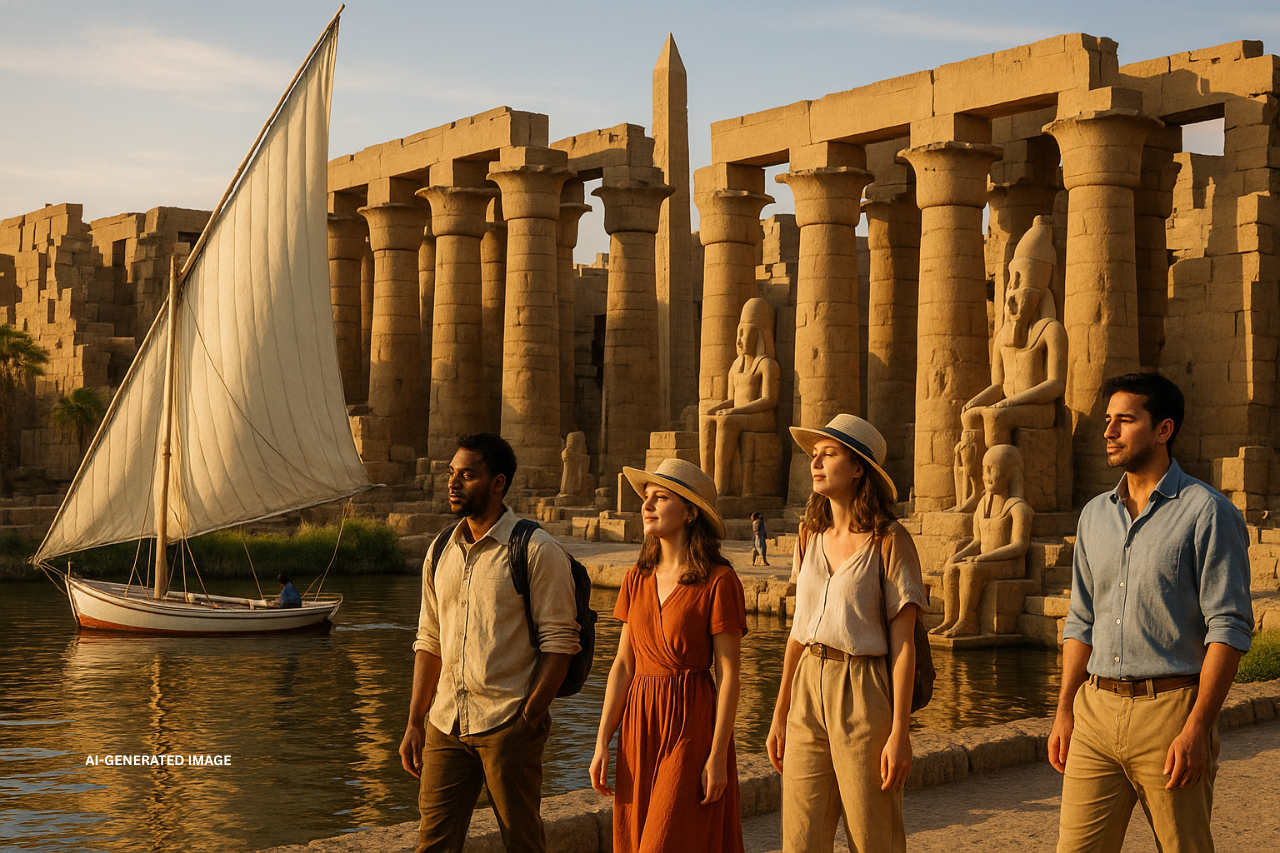
Highlights of Luxor
Valley of the Kings
Nestled in the desert hills on the west bank of the Nile, the Valley of the Kings served as the burial place of the New Kingdom pharaohs. More than 60 tombs have been discovered here, decorated with vivid wall paintings and inscriptions that reveal beliefs about the afterlife. The most famous is the tomb of Tutankhamun, unearthed nearly intact in the early 20th century.
Karnak Temple Complex
Karnak is not a single temple but a massive complex built over centuries. Dedicated primarily to the god Amun-Ra, it includes monumental gateways, towering obelisks, and the Hypostyle Hall, where 134 colossal columns rise skyward. It remains one of the most awe-inspiring sites in Egypt.
Luxor Temple
Located in the heart of the city, Luxor Temple is especially magical when illuminated at night. Originally constructed by Amenhotep III and later expanded by Ramses II, it was once connected to Karnak by an avenue of sphinxes, parts of which can still be seen today.
Temple of Hatshepsut
Carved into the cliffs of Deir el-Bahari, this mortuary temple honors one of Egypt’s rare female pharaohs, Queen Hatshepsut. Its terraces and colonnades blend seamlessly into the surrounding mountains, while its reliefs depict the queen’s reign and her famous expedition to the Land of Punt.
Colossi of Memnon
These two towering statues of Pharaoh Amenhotep III stand as guardians of what was once his grand mortuary temple. Though the temple has mostly disappeared, the statues remain an iconic landmark of Luxor’s west bank.
Experiencing Luxor by Nile Cruise
Many visitors explore Luxor as part of a Nile River cruise. These journeys, which typically run between Luxor and Aswan, combine comfort with unforgettable scenery. Cruising along the Nile offers the chance to see timeless rural landscapes, palm groves, and ancient monuments rising along the riverbanks.
Aswan – The Peaceful Gateway to Nubia
If Luxor embodies grandeur, Aswan offers peace and natural beauty. Located in southern Egypt along the Nile, Aswan is known for its stunning landscapes, Nubian culture, and impressive ancient monuments.
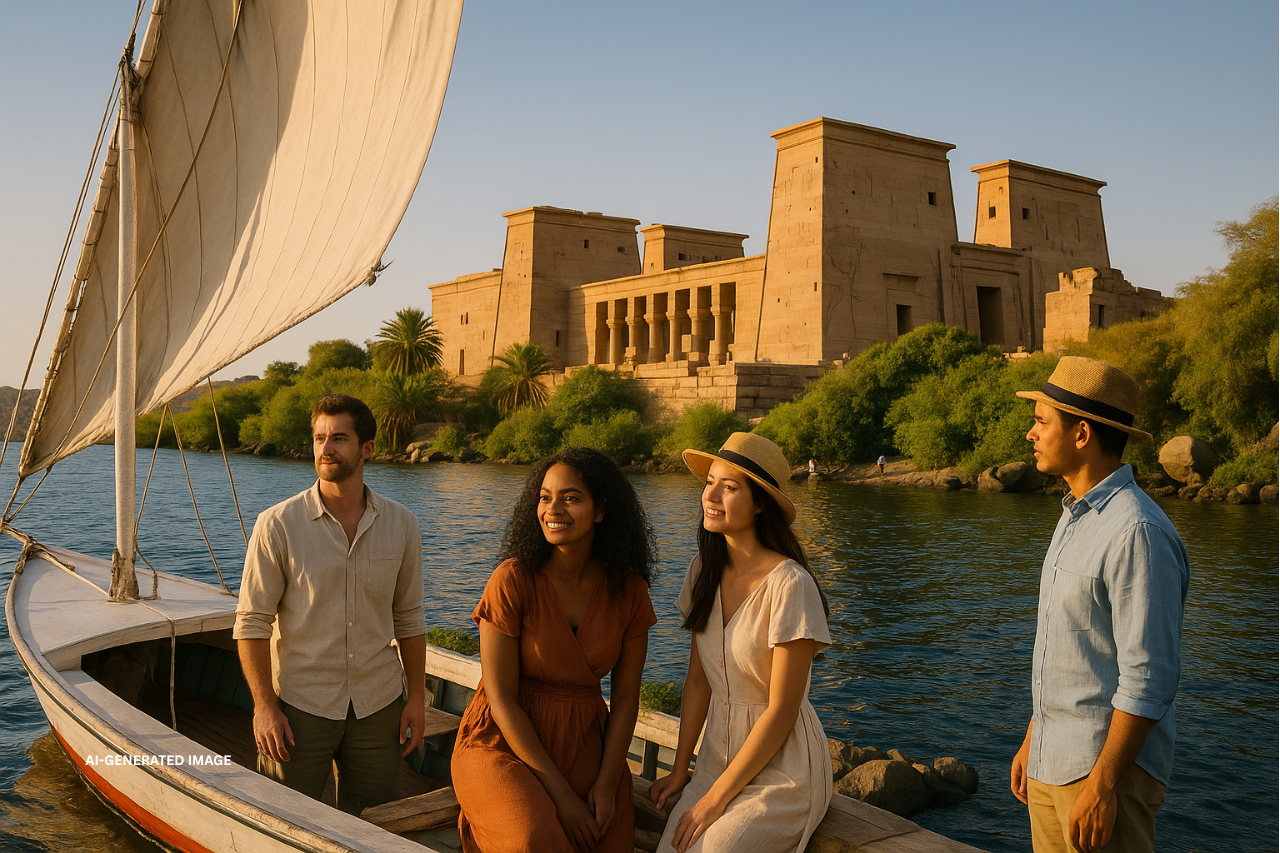
Highlights of Aswan
Abu Simbel Temples
Built by Ramses II, the Abu Simbel Temples are among Egypt’s most spectacular monuments. The larger temple features four colossal statues of Ramses II, while the smaller temple is dedicated to his queen, Nefertari. In the 1960s, the temples were famously relocated piece by piece to higher ground to save them from the rising waters of Lake Nasser.
Philae Temple
Dedicated to the goddess Isis, the Philae Temple sits gracefully on an island in the Nile and is accessible only by boat. Its columns, reliefs, and mythological carvings make it one of the most enchanting temples in Egypt.
Aswan High Dam
An engineering marvel of the modern era, the Aswan High Dam was constructed to control flooding and provide hydroelectric power. It also created Lake Nasser, one of the world’s largest artificial lakes. The dam’s scale and impact make it a site of both historical and modern significance.
Elephantine Island
This island in the Nile is home to ancient ruins, Nubian villages, and a serene environment that contrasts with the bustle of the city. Visitors can enjoy the colorful Nubian culture, traditional houses, and a slower pace of life.
The Charm of Aswan
Aswan has a calmer atmosphere compared to Cairo or Luxor. Felucca rides on the Nile, particularly at sunset, are one of the most memorable experiences here. The gentle winds, desert hills, and palm-lined banks give Aswan a sense of peace that makes travelers linger.
Alexandria – The Mediterranean Jewel
Founded by Alexander the Great in 331 BC, Alexandria was once the intellectual capital of the ancient world. Though its famed library and lighthouse are long gone, the city remains a vibrant cultural hub, blending Greco-Roman heritage with Mediterranean elegance and modern Egyptian life.
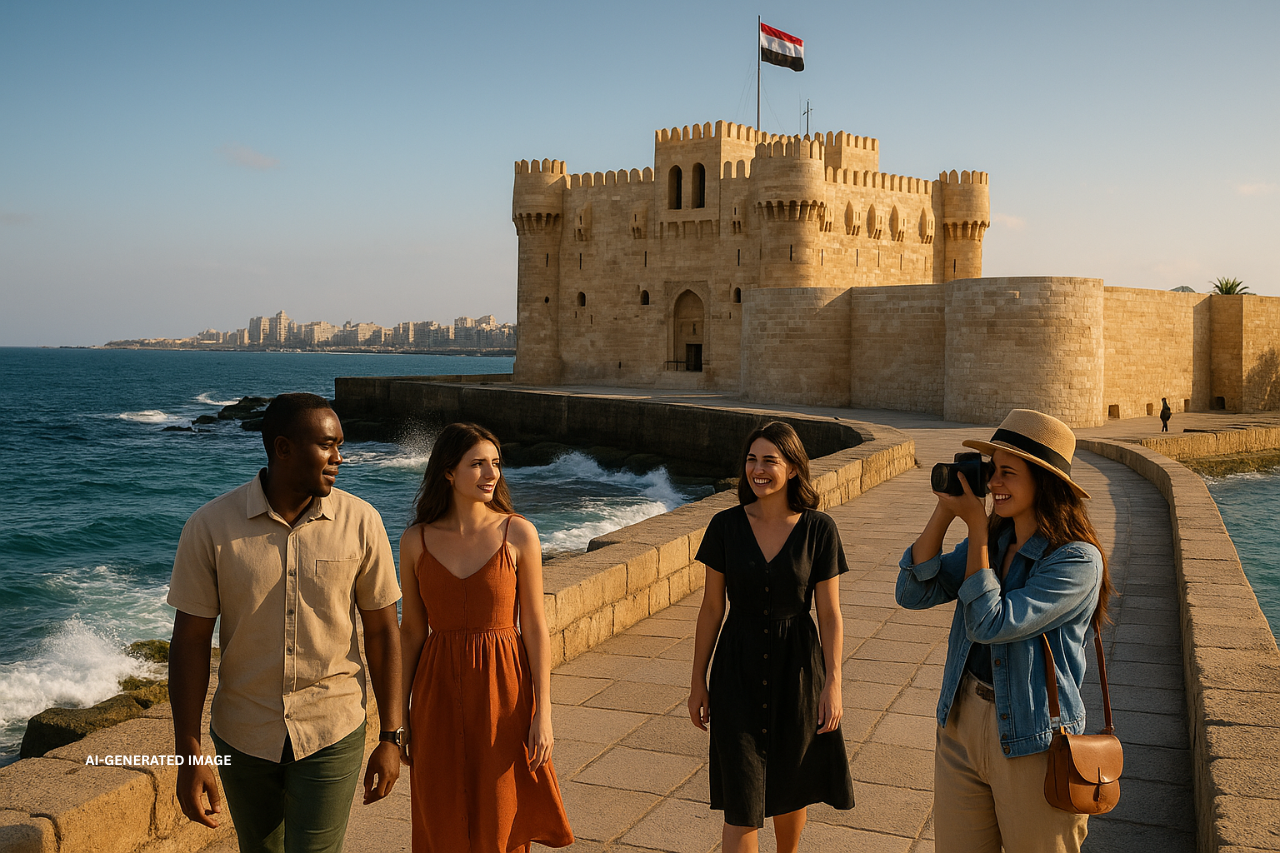
Highlights of Alexandria
Bibliotheca Alexandrina
A striking modern structure, the Bibliotheca Alexandrina honors the spirit of the ancient library. It is not only a library but also a cultural center with museums, galleries, and a planetarium. Its architecture and vast collection make it one of the city’s highlights.
Citadel of Qaitbay
Built in the 15th century on the site of the ancient Pharos Lighthouse, this fortress overlooks the Mediterranean. Its strategic position and historical significance make it one of Alexandria’s most popular attractions.
Montazah Palace and Gardens
Once a royal residence, Montazah Palace is surrounded by beautifully landscaped gardens that stretch to the sea. Today, it is open to the public and is a popular spot for walks, picnics, and relaxation.
Pompey’s Pillar
Standing nearly 27 meters tall, this Roman column is one of Alexandria’s few surviving monuments from antiquity. It marks the remains of the Serapeum, a once-magnificent temple complex.
Roman Amphitheatre
Discovered in the 20th century, this amphitheatre provides a fascinating glimpse into Alexandria’s Roman past. With marble seating and mosaics, it is one of the best-preserved Roman structures in Egypt.
The Spirit of Alexandria
With its seaside promenades, European-style architecture, and relaxed atmosphere, Alexandria feels different from the rest of Egypt. It’s a city where history, culture, and the sea blend seamlessly.
The Red Sea Riviera – A Paradise for Sun and Sea Lovers
The Red Sea Riviera is one of Egypt’s most celebrated regions for leisure and adventure. Stretching along the eastern coast, it offers sparkling waters, golden beaches, and some of the best diving spots in the world.
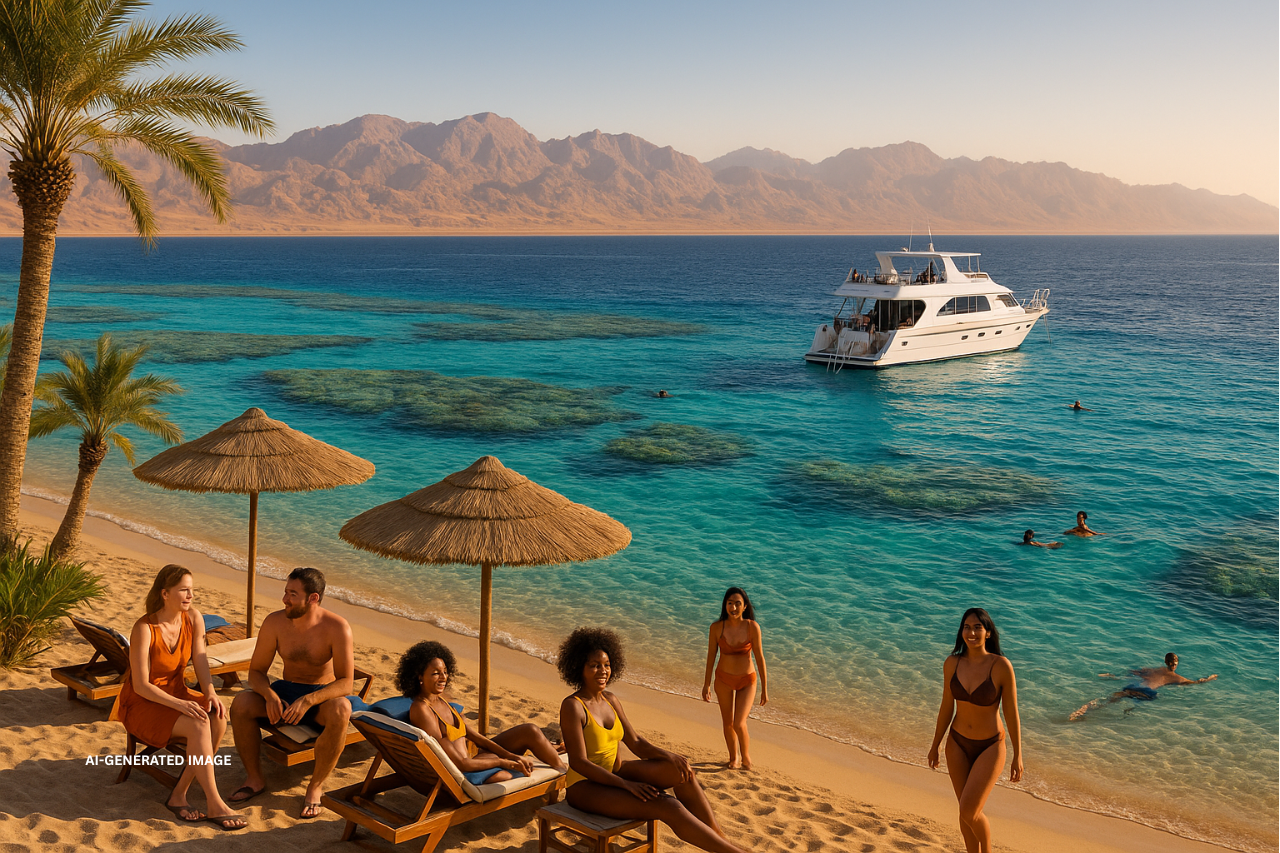
Top Destinations in the Red Sea Riviera
Sharm El Sheikh
Once a quiet fishing village, Sharm el-Sheik has grown into Egypt’s premier resort town. It combines luxury resorts, lively nightlife, and access to stunning dive sites. Visitors come here for snorkeling, scuba diving, and desert excursions.
Hurghada
Hurghada is another favorite destination, offering long sandy beaches and plenty of water sports. The city’s marina, local markets, and proximity to Giftun Island—a protected national park—make it ideal for both families and adventure seekers.
Dahab
Dahab has a relaxed, bohemian atmosphere that appeals to backpackers and divers. Its most famous site, the Blue Hole, attracts divers from around the globe, while its beachfront cafes and slower pace make it perfect for travelers seeking peace.
Ras Mohammed National Park
Located near Sharm El Sheikh, this protected area is one of the Red Sea’s treasures. Its coral reefs, colorful fish, and bird species create an underwater and coastal paradise. Many consider it one of the best snorkeling and diving locations in the world.
The Sinai Peninsula – Where Nature and Spirituality Meet
The Sinai Peninsula is a land of dramatic contrasts, where rugged mountains and coastal plains converge with deep religious significance. It has long been a sacred place for followers of Judaism, Christianity, and Islam, while also offering breathtaking natural scenery.
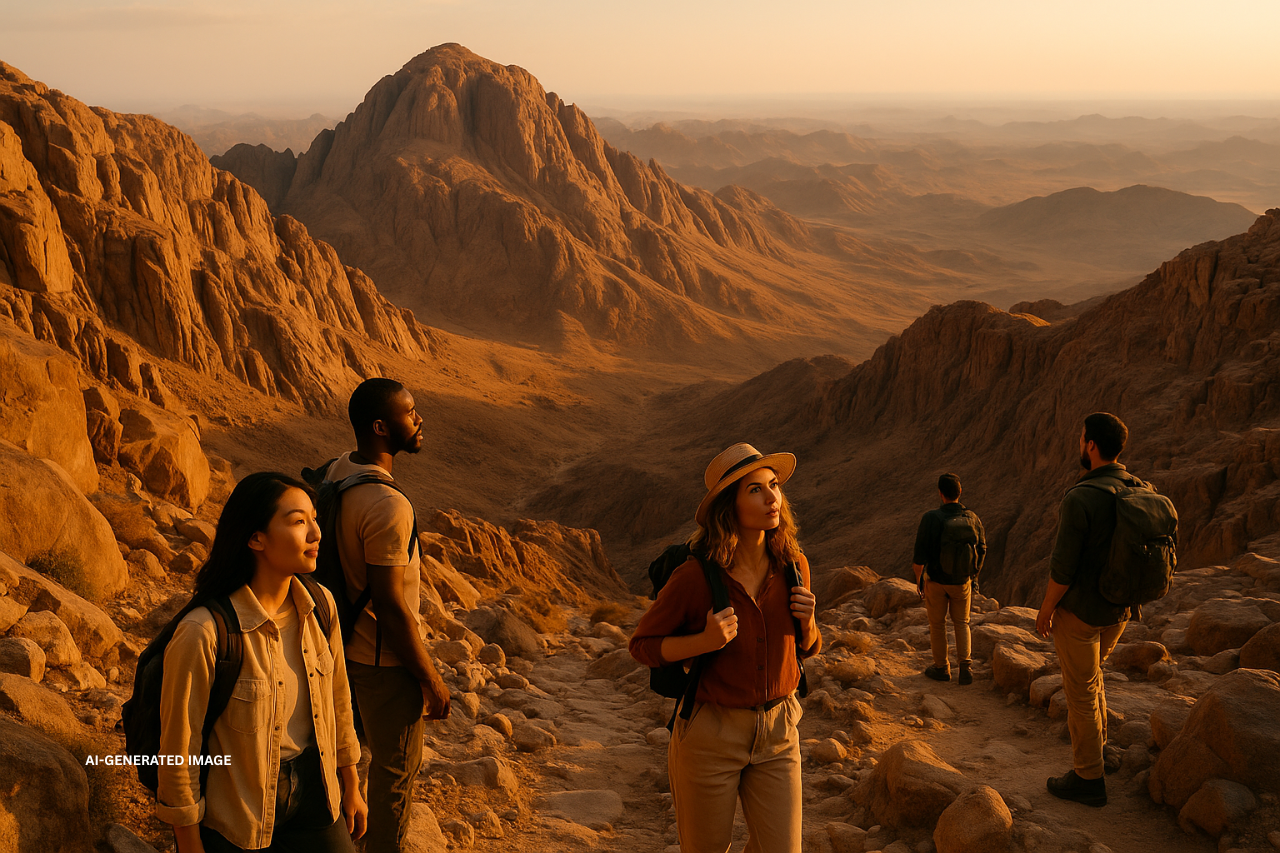
Key Attractions in Sinai
Mount Sinai
Revered across three major religions, Mount Sinai is believed to be where Moses received the Ten Commandments. Many travelers hike to its summit at night to witness a spectacular sunrise that bathes the desert in golden light.
St. Catherine’s Monastery
Situated at the foot of Mount Sinai, this UNESCO World Heritage Site is one of the world’s oldest working monasteries. It houses priceless icons, manuscripts, and relics, making it an important pilgrimage and historical site.
Colored Canyon
Famous for its multicolored rock formations, the Colored Canyon offers a unique hiking experience through winding passages of red, orange, and gold sandstone. It is a natural wonder sculpted by time and weather.
Ras Abu Gallum
This protected coastal area is known for its unspoiled coral reefs and peaceful atmosphere. Popular among divers, snorkelers, and campers, it offers a quiet escape from the busier resorts.
Nuweiba
Nuweiba is a tranquil coastal town, less developed than Sharm El Sheikh or Hurghada. Its quiet beaches, mountain views, and laid-back vibe make it a perfect retreat for travelers seeking relaxation.
The Egyptian Desert – Adventures in Timeless Landscapes
Egypt’s deserts cover most of its landmass, yet they remain among the most underrated attractions. These vast, silent expanses hold geological wonders, ancient oases, and surreal landscapes that captivate adventurous travelers.
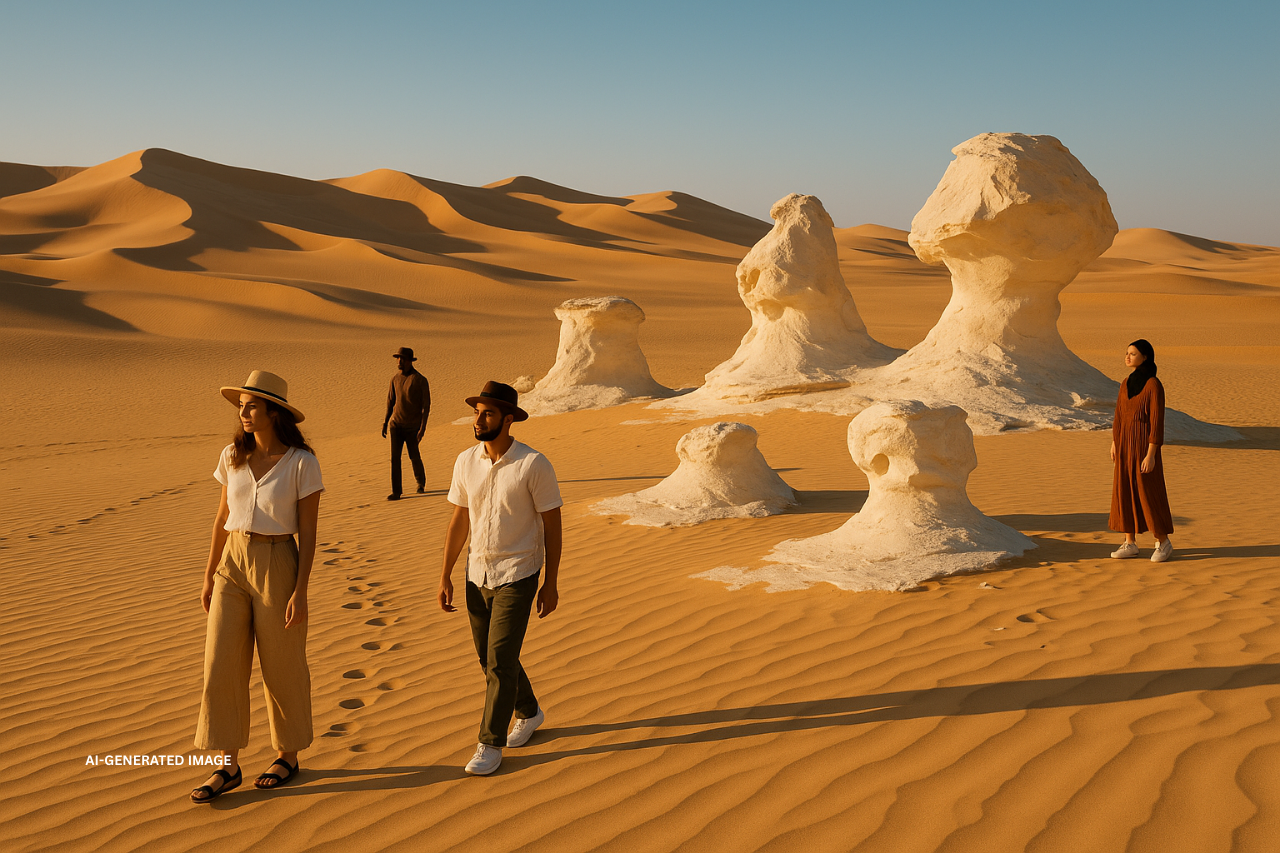
Highlights of the Desert Experience
White Desert
Located in the Western Desert, the White Desert is famous for its striking chalk-white rock formations shaped by centuries of wind erosion. These natural sculptures, resembling animals and mushrooms, create an almost otherworldly atmosphere. Overnight camping trips allow travelers to experience its silence under a blanket of stars.
Siwa Oasis
Near the Libyan border, the Siwa Oasis is one of Egypt’s most beautiful and remote oases. Surrounded by palm groves and salt lakes, it feels like a hidden paradise. The Temple of the Oracle, where Alexander the Great is said to have sought divine guidance, adds to its allure. Natural springs and traditional mud-brick architecture make Siwa both refreshing and culturally fascinating.
The Eastern Desert
Stretching between the Nile and the Red Sea, the Eastern Desert is rugged and dramatic. It contains ancient mining sites and remote monasteries, making it ideal for travelers seeking solitude and a glimpse into Egypt’s lesser-known history.
Egyptian Cuisine – A Blend of Tradition and Flavor
Food in Egypt is more than nourishment; it is a celebration of community. Meals are often shared among family and friends, and recipes have been passed down for generations. Egyptian cuisine uses simple ingredients—lentils, beans, bread, and vegetables—yet delivers bold flavors.
Popular Egyptian Dishes
-
Koshari:
-
A national favorite combining lentils, rice, macaroni, chickpeas, and crispy onions, topped with a tangy tomato sauce.
-
Ful Medames:
-
Slow-cooked fava beans flavored with olive oil, garlic, and lemon juice. Traditionally eaten for breakfast.
-
Mahshi:
-
Vegetables such as zucchini, eggplant, and bell peppers are stuffed with seasoned rice and herbs, simmered in tomato sauce.
-
Ta’ameya (Egyptian Falafel):
-
Unlike falafel made with chickpeas, the Egyptian version uses fava beans for a unique taste.
-
Desserts:
-
Favorites include basbousa (a syrup-soaked semolina cake), konafa (crispy pastry with cream or nuts), and baklava.
Beverages
-
Tea (Shai):
-
Egypt’s most popular drink, often served strong and sweet, sometimes with fresh mint.
-
Coffee (Ahwa):
-
A rich, aromatic brew, usually flavored with cardamom.
-
Sugarcane Juice:
-
A refreshing street-side drink, especially popular in summer.
Egyptian Culture – Traditions and Lifestyle
Egyptian culture blends pharaonic heritage, Islamic traditions, and Mediterranean influences.
-
Music and Dance:
-
Folk music remains popular, often accompanied by instruments like the oud and tabla. Raqs Sharqi (belly dance) is one of Egypt’s most famous cultural expressions.
-
Festivals:
-
Ramadan, Eid, and Coptic Christmas are celebrated nationwide, while arts and film festivals in Cairo and Luxor showcase modern creativity.
-
Hospitality:
-
Egyptians are famously warm and welcoming. Guests are treated generously, often with tea, food, and open conversation.
Shopping – From Souks to Modern Malls
Shopping in Egypt is as much about the atmosphere as it is about the items. Bustling markets invite you to bargain, while modern malls offer international comforts.
Traditional Markets
-
Khan El Khalili (Cairo):
-
A centuries-old bazaar filled with spices, jewelry, lamps, and souvenirs.
-
Luxor and Aswan Souks:
-
Known for alabaster carvings, papyrus art, and handwoven textiles.
What to Buy
-
Papyrus Paintings:
-
Hand-decorated artworks inspired by ancient Egyptian themes.
-
Perfume Oils:
-
Natural essences like lotus, jasmine, and sandalwood.
-
Jewelry:
-
Gold and silver designs influenced by pharaonic motifs.
-
Carpets and Scarves:
-
Beautifully crafted by local artisans.
Modern Shopping
In cities such as Cairo and Alexandria, luxury malls and boutique shops mix with traditional markets, giving visitors a full range of shopping experiences.
Best Time to Visit
Weather and festivals play a big role in planning a trip.
-
October to February:
-
Mild and pleasant, ideal for sightseeing in Cairo, Luxor, and Aswan.
-
March to May:
-
Warm with occasional desert winds (khamsin). Great for coastal travel.
-
June to September:
-
Hot, particularly in Upper Egypt, but quieter and cheaper. Perfect for Red Sea resorts.
Festivals to Experience
-
Ramadan:
-
The holy month of fasting, prayer, and evening feasts.
-
Abu Simbel Sun Festival:
-
Celebrated twice yearly (February and October) when sunlight illuminates the temple’s inner sanctum.
-
Coptic Christmas:
-
Observed on January 7 with special church services and celebrations.
Essential Travel Tips
Etiquette
-
Dress modestly, particularly in mosques or conservative areas.
-
Tipping (baksheesh) is customary for guides, drivers, and service staff.
-
A smile and a polite greeting go a long way in social interactions.
Safety
-
Stay within recognized tourist areas.
-
Drink bottled water instead of tap water.
-
Be cautious with street vendors and negotiate prices fairly.
Transportation
-
Metro (Cairo): Fast and affordable.
-
Trains: Connect Cairo to Alexandria, Luxor, and Aswan.
-
Domestic Flights: Convenient for covering long distances.
Currency
-
The local currency is the Egyptian Pound (EGP).
-
Credit cards are widely accepted, but cash is essential for markets, taxis, and tips.
Conclusion
Egypt is a country where history and modern life flow side by side, much like the Nile running through its heart. From the timeless Pyramids of Giza to the colorful markets of Cairo, from the peaceful beauty of Aswan to the cultural elegance of Alexandria, Egypt’s appeal lies in its remarkable contrasts.
This is a land where ancient tombs and temples stand proudly, telling the stories of pharaohs and gods, while vibrant cities showcase contemporary culture and hospitality. The Nile River remains Egypt’s lifeline, linking its fertile valleys and historical treasures. Meanwhile, the Red Sea Riviera and Sinai Peninsula reveal a natural beauty that rivals its monuments.
Yet what leaves the deepest impression on travelers is not only the grandeur of Egypt’s landscapes and landmarks but also the warmth of its people. Egyptians welcome visitors with generosity, humor, and a sense of pride in their heritage. Every encounter, whether over a shared cup of tea or during a guided tour, adds another layer to the experience.
For adventurers, history enthusiasts, or those simply seeking relaxation, Egypt is more than a destination—it is an unforgettable journey through time and culture.
FAQs
What is the best time to visit Egypt?
The cooler months from October to February are the most comfortable for sightseeing. Summer (June–September) can be very hot, but it is a great season for beach vacations along the Red Sea due to fewer crowds and lower prices.
Is Egypt safe for tourists?
Yes, Egypt’s major tourist destinations, such as Cairo, Luxor, Aswan, and Red Sea resorts, are generally safe. Standard precautions—such as avoiding isolated areas at night and being alert to scams—are advised.
Do I need a visa to travel to Egypt?
Most travelers require a visa. Egypt offers visa-on-arrival and e-visas for many nationalities. It’s best to check the current requirements based on your passport before traveling.
What currency is used in Egypt?
The official currency is the Egyptian Pound (EGP). Credit cards are accepted in most hotels and malls, but carrying small cash is important for taxis, markets, and tipping.
What clothes should I pack?
Light, breathable clothing is recommended for the daytime heat, along with modest attire for religious sites. Comfortable shoes, sunscreen, and a hat are essential. A light jacket or sweater is useful for cool desert nights or winter months.
Is a Nile cruise worth it?
Definitely. A cruise between Luxor and Aswan is one of the best ways to explore Egypt. It combines comfort with access to iconic sites such as Karnak Temple, the Valley of the Kings, and Abu Simbel.
Can Egypt be visited on a budget?
Yes. Street food is inexpensive, local trains and buses are affordable, and many budget hotels or guesthouses are available. Bargaining in markets also helps keep costs down.
What are Egypt’s must-see attractions?
-
Pyramids of Giza and the Sphinx (Cairo)
-
Valley of the Kings and Karnak Temple (Luxor)
-
Abu Simbel Temples (Aswan)
-
Bibliotheca Alexandrina and Qaitbay Citadel (Alexandria)
-
Ras Mohammed National Park (Red Sea)
-
Mount Sinai and St. Catherine’s Monastery (Sinai)
Is tipping expected in Egypt?
Yes. Tipping (baksheesh) is a common part of Egyptian culture. Small tips are appreciated for guides, drivers, hotel staff, and even for small services such as helping with luggage.
Is Egypt family-friendly?
Yes. Families often find Egypt enjoyable, as children are fascinated by pyramids, boat rides on the Nile, and beach resorts. Many hotels and resorts have kid-friendly amenities.
Final Thoughts
Egypt is not just a holiday spot—it is a place that inspires and transforms. Every site, from the colossal pyramids to quiet desert oases, carries a story. Every interaction, from bargaining in a souk to sharing a meal, adds depth to the experience.
For travelers, Egypt is more than a trip. It is a journey into history, culture, and humanity that leaves memories to treasure for a lifetime.
